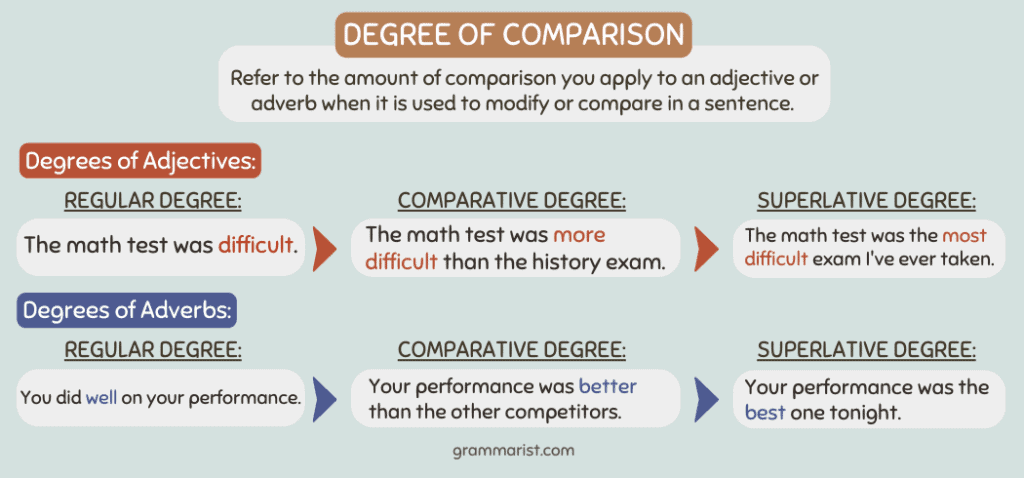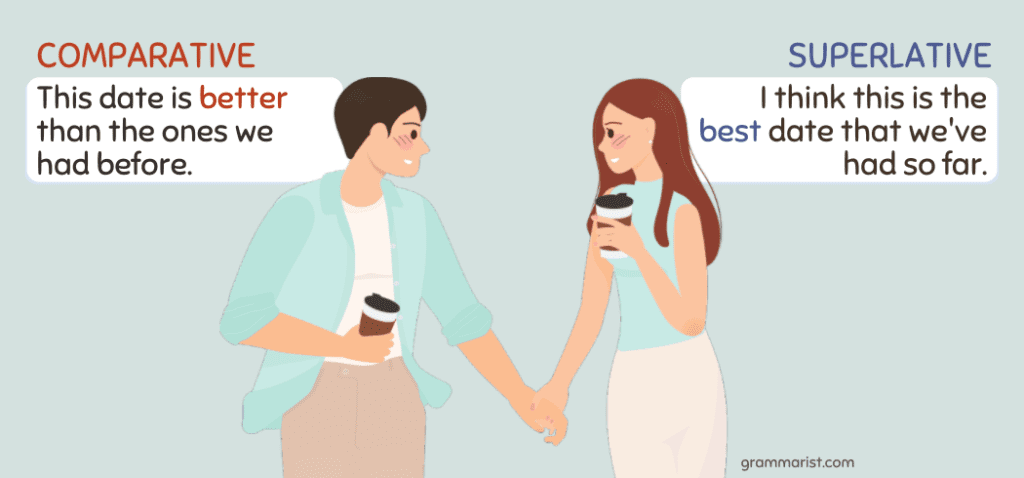The first things an English language student will learn are the parts of speech. The parts of speech are the categories a word is assigned to understand and recognize its syntactic functions.
Once students of the English language master this knowledge, they need to learn how to modify them. Adjectives and adverbs, in particular, are used to modify other parts of speech. Most adjectives and adverbs have three forms, called regular, comparative, and superlative degrees. These are used to modify or make comparisons between two or more nouns and certain verbs.
Let’s take a closer look at the comparative and superlative forms of adjectives and adverbs and how to use them.
What Is a Degree of Comparison?

Degrees of comparison refer to the amount of comparison you apply to an adjective or adverb when it is used to modify or compare in a sentence. Each of the three degrees of comparison has a name: Regular (also called positive), comparative, and superlative. The regular degree is the original adjective or adverb form.
There are different ways to form the comparative and superlative degrees of adjectives and adverbs to compare or modify nouns and verbs. The form of an adjective or adverb helps determine whether it is in comparative or superlative form.
For example:
Degrees of Adjectives
| Regular | Comparative | Superlative |
| Good Simple Impressive | Better Simpler More impressive | Best Simplest Most impressive |
Degrees of Adverbs
| Regular | Comparative | Superlative |
| Well Soon Impressively | Better Sooner More impressively | Best Soonest Most impressively |
Comparative and Superlative Forms
Modifiers can be regular or irregular depending on how their comparative and superlative degrees are formed. Be careful not to exaggerate using a modifier, which can make your writing sound excessive or overly stressed. For example, avoid a superlative adjective modifier when one degree of comparison is all you need.
Regular Form
Regular modifiers have two rules of formation.
Rule #1
Use -er or more to form the comparative degree and -est or most to form the superlative degree of most one and two-syllable modifiers.
The most common method is the use of -er and -est, but use more and most if -er and -est sound awkward.
For example:
| Regular | Comparative | Superlative |
| Loud Shiny Famous | Louder Shinier More famous | Loudest Shiniest Most famous |
The comparative and superlative degrees of all adverbs that end in -ly, regardless of the number of syllables, use more and most.
For example:
| Regular | Comparative | Superlative |
| Evenly | More evenly | Most evenly |
Rule #2
Use more and most to form the comparative and superlative degrees of all modifiers with three or more syllables.
Comparing Using Less and Least
Less and least are the opposite of more and most and are also used to form comparative and superlative degrees of most modifiers.
| Regular | Comparative | Superlative |
| Tall Hopeless Ambitious | Less tall Less hopeless Less ambitious | Least tall Least hopeless Least ambitious |
Irregular Form
The irregular forms of comparative and superlative degrees are called such because they are formed in unpredictable ways. Just like the regular form of the modifier, irregular forms also have two rules to remember.
Rule #1
The forms of some irregular modifiers differ only in the regular degree, and their comparative and superlative forms must be memorized.
For example,
| Regular | Comparative | Superlative |
| Bad Badly Far Far Good Little Ill Late Many Much Well | Worse Worse Father Further Better Less Worse Later More More Better | Worst Worst Farthest Furthest Best Least Worst Last or Latest Most Most Best |
Rule #2
Bad is an adjective, so you should never use it to modify an action verb. Badly is an adverb, and you do not use it after a linking verb.
For example:
| Incorrect | Correct |
| Michael plays baseball bad. Michael feels badly. | Michael plays baseball badly. Michael feels bad. |
Using Comparative and Superlative Degrees in Sentences

There are two simple rules to apply to comparative and superlative degrees when used in a sentence. Make sure to make logical comparisons and do not mistakenly compare two unrelated items, nor do you want to compare something with itself.
Rule #1
Use the comparative degree to compare two people, places, or things.
For example:
- My advanced class was more difficult to convince to keep a planner than my regular class.
- Her photography was much more detailed than the runner-up’s piece, which is why she won first place.
Rule #2
Use the superlative degree to compare three or more people, places, or things.
- He wanted to buy the most expensive car in the used car lot but settled on what fit his budget.
- This museum has the largest number of sculptures compared to anywhere else in the country.
Let’s Review
Comparative and superlative adjectives and adverbs provide degrees of comparison between two or more nouns or adverbs. They can be regular or irregular, depending on how they are formed. Regular forms are easy to modify, but irregular forms usually require memorization to remember the differences between comparative and superlative forms.